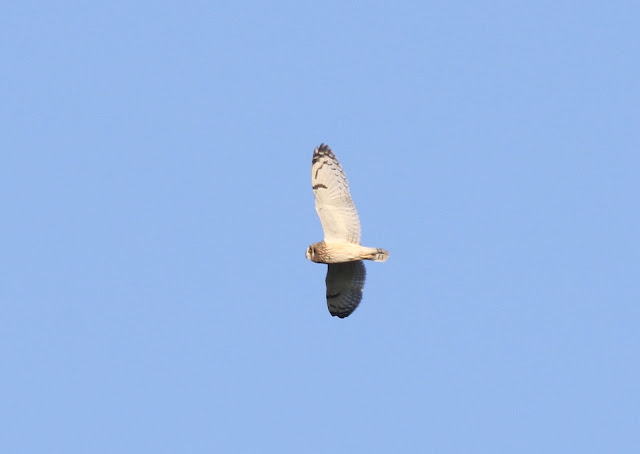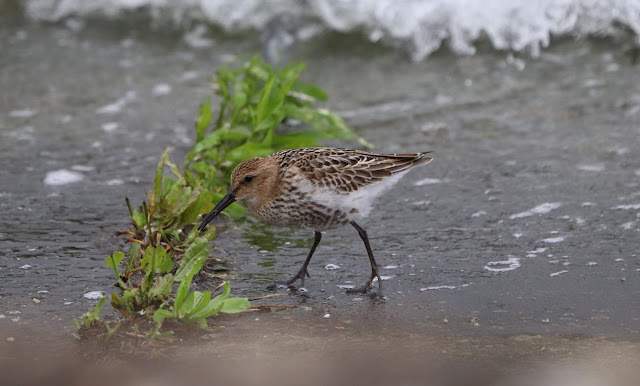Little Ringed Plover photo-bombing Dunlin on Lockwood pic @Chris_Farthing
Summer saw excellent breeding records including the first ever fledged Barnacle Goose, solid wader passage and the usual crop of out-of-season oddities, Wigeon, Spotted Flycatcher and Black Redstart were added to the year list in June with Raven making a flying visit in July. The four additions take the total so far to 132 - nine ahead of last year, but the same total as in 2021.
The first ever successful breeding of Barnacle Geese took place on No 5 pic @Elliott81758817 After failed attempts in the last two years, Barnacle Geese finally succeeded in raising young.. The disappearance of the family from their home around No 4/5 on July 23rd had raised fears that, as last year, foxes had caught the last remaining youngster so there was relief when the family were then seen flying in from the playing fields. Another pair tried to nest on the big No 5 island but the eggs look as if they failed to hatch. For the third successive year, a flock of adults - presumably from further up the Lea Valley - also arrived on No 5 to moult in July.
It was an equally happy story of breeding success with Shelduck. After two years when none of the young survived, five birds from two broods have already fledged and left the Wetlands with a single smaller young from a third brood still going strong at the end of July. Gadwall have also raised one large family successfully while the number of Pochard - a rare UK breeder - was up from 15 to 16 broods. As usual, new Tufted Duck families were still appearing into August but numbers seem to be down on last year's total of 46 broods at the end of July although keeping an accurate count is difficult when the young disappear so fast.
Hard to believe a bird as bright as this drake Mandarin could disappear but it did pic @MLP
June saw the the year's second Mandarin - found by MLP - arrive on the 23rd for the species's typical brief appearance. Wigeon had been the most glaring omission from the year list but it was still a surprise when a drake was found on High Maynard on the very untypical date of June 3rd.
A very out-of-season Wigeon on High Maynard pic @Elliott81758817
Just one Red Kite was recorded on June 24th but Buzzards were more frequent with sightings on June 4th, 9th, 12th, 23rd and 29th which was pretty much a complete reversal of the two species occurrence last summer. There was little sign that Hobby had bred nearby with only single records on June 17th and July 9th. With Peregrines a much rarer sight on the pylons around the Wetlands than usual, Sparrowhawk was the commonest raptor - often seen carrying food - while Kestrels also wandered over occasionally from Tottenham and Walthamstow Marsh.
Ten species of wader - the same as last summer - were seen with May's strong and late passage continuing into early June and the first birds heading south only a couple of weeks later. The most surprising omission from the list was Black-tailed Godwit with no records this summer compared to over 40 birds - including two large flocks - either over or on the reservoirs last July, There has only been one record all year so far.
Lapwing were seen on six dates in June and July pic @giles_greenwood
But Oystercatcher which weren't seen last summer made a come-back with singles on June 6th, July 13th & 14th and two on July 9th. Lapwing were seen on four dates in June with two on the 8th with a further record on July 13th. A late Ringed Plover was seen on June 1st & 2nd with a more expected adult Little Ringed Plover also on the latter date. July saw more Little Ringed Plovers with birds - largely juveniles - on July 1st, 2nd, 14th, 15th, 16th, and two on the 17th.
 Adult Ringed Plover (above) @Chris_Farthing and juv Little Ringed Plover @Elliott81758817
Adult Ringed Plover (above) @Chris_Farthing and juv Little Ringed Plover @Elliott81758817
May's exceptional showing by
Sanderling continued with a final bird on June 1st. A late
Dunlin was also seen that day with returning birds on July 5th and 17th. Single
Curlew flew over on June 29th and July 8th. It was also a very good summer for
Redshank with singles on June 2nd, 3rd and 6th with two on 14th with records in July on 13th, 19th, with two again on July 25th and 30th. There had only been two records last year by the end of July.
There was a gap of less than three weeks before the last two Common Sandpiper going north on June 2 and what was presumably the first returning bird on the 21st, four days earlier than last year. The species was then seen every day in July with numbers building to a maximum count of 18 on the 26th. Green Sandpipers as usual returned even earlier with two on June 20th in heavy rain but, unusually, this was the only record of the summer.
Redshank were surprisingly regular visitors pic
@Elliott81758817
In what is the first breeding since 2016 at the Wetlands, a pair of
Great Black-backed Gulls successfully raised one young on the small No 5 island. They were excellent parents with one bird always staying close to the youngster which was often hidden in the vegetation. The species is a rare breeder in London with no records in 2021 and just one in the previous two years.

Great Black-backed Gull keeping a close watch on its chick pic @Chris_Farthing
In contrast, numbers of young of both Black-headed Gulls and Common Terns appeared to be down this summer. Black-heads seemed to be the main victims of Avian Flu this year at the Wetlands which, although it thankfully did not seem too severe, may have had an impact on the young packed on the raft on Lockwood.
Perhaps only four or five pairs of Common Terns successfully nested - all this summer on East Warwick - where they raised at least six young. This compares to ten pairs on West Warwick alone last year with others nesting on Lockwood. But it seems as if the colony has just moved half a mile north of the Wetlands to Banbury where at least 10 pairs nested and, from the evidence adults carrying fish, did very well. Adult Mediterranean Gulls were seen on June 17th and July 5 with Yellow-legged Gulls picked out on Lockwood by RE on July 11th and 15th, over two weeks earlier than last year's first sightings.
Mediterranean Gulls were attracted by nesting Black-heads pic @magnusphotog
Raven are moving into the outskirts of London and this year have raised young just a few miles up the Lea Valley so should become a more regular visitor. But it remains rare and the first since 2021 was seen by visiting Irish birder PM over the Engine House on July 7th. Kingfishers are the bird most visitors want to see and they did not disappoint this summer. The pair which nested on No 5 no sooner seemed to fledge one set of young than they set about rearing a second brood, with both adults and young delighting photographers while a second pair often fed on the Coppermill south of Lockwood.
Swift numbers, as expected, fell from the middle of July as local breeders started their migration but should build again in August as northern birds use the reservoirs as a service station to break their journey south. Sand Martins also began to move in small numbers in July with the occasional Swallow passing through on July 3, 20th, 23rd and 25th.
A Wetlands Blackcap was retrapped in Spain three months after it was rung
There seemed to be plenty of young Chiffchaffs and Blackcaps around the Wetlands with good numbers of Reed Warblers also caught in the regular ringing sessions. Among the birds rung last June was a Blackcap which was re-caught near Zaragoza in Spain three months later - a journey of 1095 km.
June Wheatears are now becoming regular @Chris_Farthing
A Garden Warbler, which may have bred nearby, was caught on July 9th with a second bird seen on the 21st while the first returning Willow Warbler arrived on the last day of July, two days later than last year but on the same date as in 2021. The Spotted Flycatcher seen on June 26th along the 123 path and the male Black Redstart at the south end of Lockwood on the 30th were both unexpected and both new for the year. But there now seems to be a regular pattern of Wheatear turning up in June with a late - or early - bird on the 7th, the third year running the Wetlands has had a record this month..
 An inquisitive Short-eared Owl circled Lockwood pics @Elliott81758817
An inquisitive Short-eared Owl circled Lockwood pics @Elliott81758817






















































.PNG)





